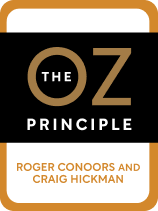

This article is an excerpt from the Shortform book guide to "The Oz Principle" by Roger Connors, Tom Smith, and Craig Hickman. Shortform has the world's best summaries and analyses of books you should be reading.
Like this article? Sign up for a free trial here .
Is The Oz Principle worth reading? What does the story of Dorothy from The Wizard of Oz have to do with leadership?
In their book The Oz Principle, authors Roger Connors, Tom Smith, and Craig Hickman use the story of The Wizard of Oz to show how being accountable for your successes and challenges is the key to improving results on both an individual and organizational level.
This The Oz Principle review takes a look at the book’s impact, background, and key strengths and weaknesses.
About the Authors
Roger Connors and Tom Smith are the founders of the consulting firm Partners in Leadership. They’ve worked with numerous companies to improve cultures and practices around accountability, and The Oz Principle contains many anecdotes about how their clients overcame workplace issues. They co-authored two other New York Times bestselling management books: How Did That Happen? and Change the Culture, Change the Game.
The third author, Craig Hickman, is a prolific writer as well; his works include Creating Excellence, Results Revolution, and other nonfiction titles, but he also delved into thrillers with The Insiders and its sequel. He’s a regional vice president at Partners in Leadership and was previously the CEO of Headwaters Technology Innovation Group.
The Book’s Publication
The Oz Principle was first published in 1994 by Portfolio, an imprint of Penguin Random House. According to PRH, it has sold almost 600,000 copies; a revised version was released in 2004, 10 years after its initial publication. The updated version includes a preface and an acknowledgements page thanking the readers who helped The Oz Principle succeed.
The Book’s Impact
According to Partners in Leadership, The Oz Principle was a New York Times, Wall Street Journal, and Publisher’s Weekly bestseller, and the president and publisher at Portfolio described it in 2009 as among their top five bestselling books in the Leadership and Performance categories, year after year, since 1994. Companies conduct workshops based on the book’s ideas, and universities teach it in business courses.
The Book’s Strengths and Weaknesses
Critical reviews state that the book is repetitive, and that its message is too simple. Some people feel the book could have been much shorter, that it’s boring, that there are too many examples, and that its advice isn’t specific enough. Lastly, some reviews characterize The Oz Principle as, essentially, corporate propaganda designed to convince employees to take the blame for any unhappiness they feel at work rather than criticizing the failings of their supervisors and their company’s culture. However, other readers find the book’s ideas empowering, logical, and easy to understand. They like that the principles were relevant to all parts of their lives, not just work.
The Oz Principle reviews do raise valid points; the book is repetitive, but many people find its ideas clear and relevant to their lives.
Commentary on the Book’s Approach
The Oz Principle is split into three parts—the first introduces the problem (having a victim mentality), the second offers guidelines for addressing it, and the third provides suggestions for applying those solutions on an organizational scale. Anecdotes about the trials and triumphs of various companies, some of which the authors worked with and others they didn’t, make up the bulk of the book’s content.
The inclusion of client anecdotes, with frequent emphasis on how The Oz Principle’s ideas enabled them to overcome their problems, at times make the book sound like an advertisement for itself. However, the anecdotes illustrate the book’s sometimes abstract ideas.

———End of Preview———
Like what you just read? Read the rest of the world's best book summary and analysis of Roger Connors, Tom Smith, and Craig Hickman's "The Oz Principle" at Shortform .
Here's what you'll find in our full The Oz Principle summary :
- Why you have more power to create change than you may realize
- How to stop thinking like a victim
- The four steps to mastering accountability






